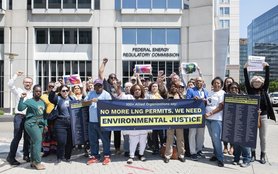WASHINGTON, DC — A number of "hotspots" of vulnerability to climate-related hazards exist in the US southeast, according to a new groundbreaking study released today by Oxfam America. The report, "Exposed: Social Vulnerability and Climate Change in the US Southeast," is the first of its kind to combine hazards associated with climate change with social variables, revealing the people and places that will most likely to be hit worst by climate change.
"Climate change will impact everyone, but not everyone will be impacted equally," said Oxfam America President Raymond C. Offenheiser. "Social factors like income and race do not determine who will be hit by a natural disaster, but they do determine a population’s ability to prepare, respond, and recover when disaster does strike. This report will serve as a critical tool to help us identify especially vulnerable communities and invest wisely in their climate resiliency and preparedness."
The study covers 13 states in the US southeast from Arkansas to Virginia, measuring the underlying social and demographic characteristics of populations and how some of those characteristics negatively affect their ability to cope with climate change-related hazards, such as flooding, drought,hurricane force winds and sea-level rise. Poverty is deepest in the rural South where more than one in four people live in counties with persistent poverty, and it is therefore one of the country’s most socially vulnerable regions to climate change.
"We have already seen that climate-related disasters hit some populations worse than others," said Benjamin Todd Jealous, President and CEO of the NAACP. "From drought in western Alabama to hurricanes in Louisiana, this research is instrumental in helping to identify those areas that are most vulnerable, so that we can better prepare and help before disaster hits."
The study was conducted using the Social Vulnerability Index and overlaying it with data of climate change-related hazards. The tool was developed by Dr. Susan Cutter and Dr. Christopher Emrich at the Hazards and Vulnerability Research Institute at the University of South Carolina.
"While the USGS was not involved in the Oxfam report, our recent work revealed very similar findings about vulnerability hotspots in the Southeast," said US Geological Survey scientist Virginia Burkett. "It is vitally important that we understand vulnerabilities at a regional and local scale so that they can be incorporated into future risk assessments and adaptation planning. Our decisions today will determine the severity of climate change impacts in the future."
"Climate change is happening and it’s affecting the poor—socially and economically vulnerable communities—first. As climate change increases and intensifies floods, storms, and heat waves, many of the world’s poorest communities, from Biloxi to Bangladesh, will experience unprecedented stress," said Offenheiser. "Congress must act now to address climate change and invest in the resiliency of poor communities on the frontlines of climate change at home and abroad."


